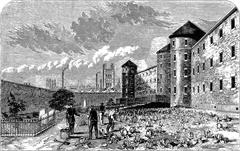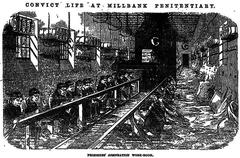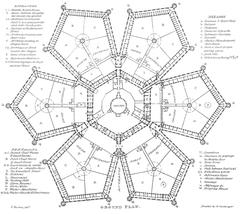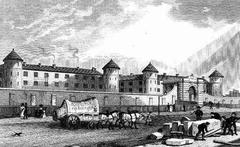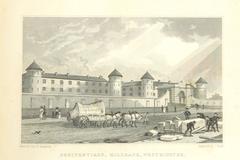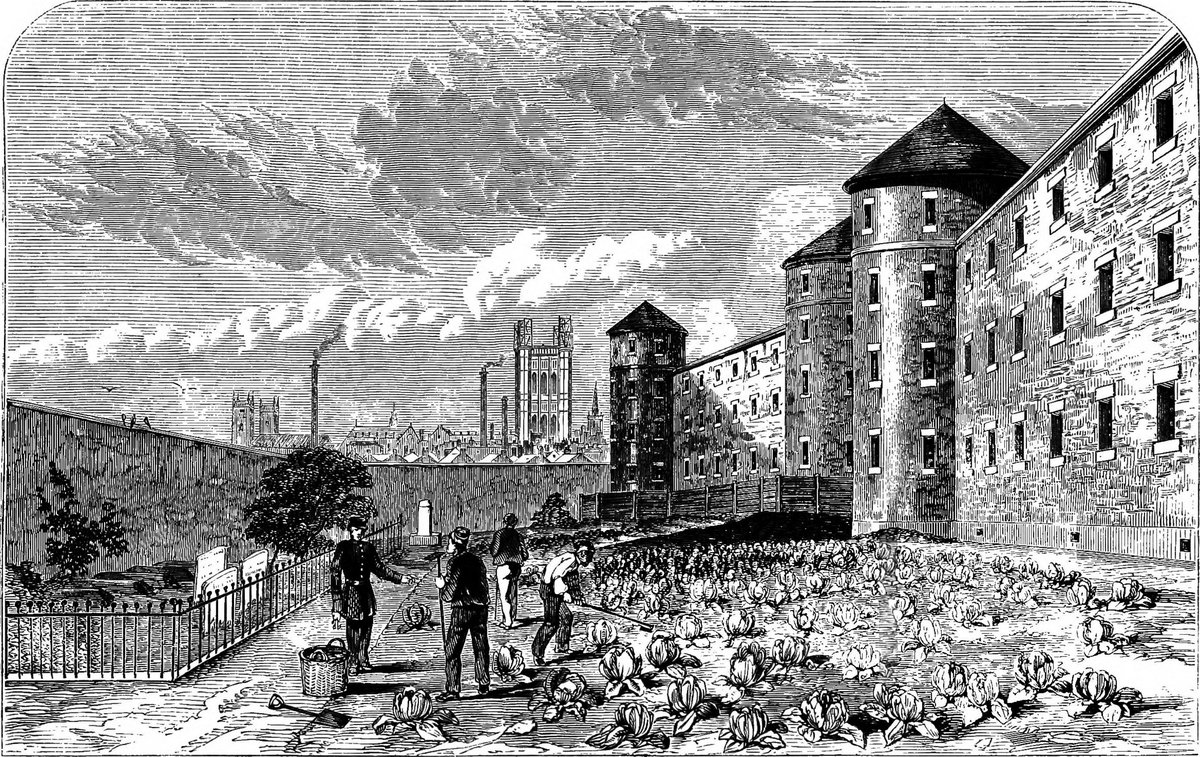
Millbank Prison Visiting Hours, Tickets, and London Historical Sites Guide
Date: 15/06/2025
Introduction: Millbank Prison’s Historical Significance
Millbank Prison was a landmark of British penal reform and a defining feature in the evolution of London’s urban landscape. Established in the early 19th century as Britain’s first national penitentiary, Millbank embodied the ideals—and challenges—of early attempts at prisoner rehabilitation and surveillance. Its innovative design, inspired by Jeremy Bentham’s Panopticon, and its subsequent role as a transportation depot for convicts bound for Australia, left an indelible mark on the city. Though demolished in the 1890s, Millbank’s influence endures in the street layout, surviving architectural remnants, and the transformation of its grounds into the site of the renowned Tate Britain art gallery.
This guide provides a detailed exploration of Millbank Prison’s history and legacy, with practical information on how visitors can engage with the site today. It covers nearby attractions, accessibility, and travel tips, while also highlighting the broader impact of Millbank on London’s penal and architectural history. (Tate Britain, Victorian London, CityDays)
Table of Contents
- Introduction
- The Origins and Construction of Millbank Prison
- Millbank’s Operation and Purpose
- Architecture and Daily Life
- Role as a Transportation Depot
- Closure and Urban Transformation
- Visiting the Millbank Site Today
- Millbank’s Urban and Cultural Legacy
- Influence on Penal Reform
- Remnants and Archaeology
- Community and Social Impact
- Research and Historical Records
- FAQs
- Conclusion
- References
The Origins and Construction of Millbank Prison
Millbank Prison, also known as the Millbank Penitentiary, arose from the Penitentiary Act of 1779, which advocated for reformative alternatives to traditional punishments. Its design drew from Bentham’s Panopticon, emphasizing surveillance and discipline. The marshy Thames-side site, acquired in 1799, presented formidable engineering challenges—eventually overcome by Robert Smirke’s innovative use of a concrete raft foundation. Completed in 1821, the prison’s vast hexagonal plan with radiating blocks once made it the largest prison in London. (CityDays, Victorian London)
Millbank’s Operation and Purpose
The prison opened in stages—first for women in 1816, then for men in 1817—with a mandate to instil penitence through isolation and silence. Early regimes were strict, but the psychological toll of solitary confinement soon became apparent, prompting modifications to daily routines and the eventual abandonment of the “separate system.” (theprison.org.uk)
Architecture and Daily Life
Millbank’s labyrinthine structure comprised six pentagonal cell blocks radiating from a central hub, with Martello-like towers and sparse, utilitarian cells. The site was plagued by sanitation problems and outbreaks of disease, exacerbated by its marshy foundations. The confusing layout challenged staff and prisoners alike, and harsh discipline was the norm. (alondoninheritance.com)
Role as a Transportation Depot
By the 1840s, Millbank’s principal function shifted to serving as a holding depot for convicts awaiting transportation to penal colonies—primarily Australia. Each year, thousands passed through its gates en route to exile, marking Millbank as a central node in the machinery of imperial punishment. (Victorian London, CityDays)
Closure and Urban Transformation
Following the abolition of large-scale convict transportation, Millbank’s prison function declined. It was repurposed for military and probationary use before closing in 1890. Demolition began in 1892, making way for major urban renewal projects, including the construction of Tate Britain and the Millbank Estate. (theprison.org.uk)
Visiting the Millbank Site Today
Visiting Hours and Tickets
Millbank Prison itself no longer exists, so there are no direct visiting hours or tickets. However, visitors can explore the history of the site through the Tate Britain art gallery and surrounding public spaces.
- Tate Britain: Open daily, 10:00 AM–6:00 PM (Fridays until 10:00 PM). Entry to the permanent collection is free; special exhibitions and architecture tours require tickets (Tate Britain).
- Architecture Tours: Guided tours focusing on the site’s transformation run regularly and require advance booking (Tate Britain Architecture Tour).
What to See
- Tate Britain: Built on the former prison grounds, Tate Britain is a world-class art gallery that occasionally references the site’s penal history.
- River Bollard and Memorial Plaque: On the Thames Path near Tate Britain, a stone bollard with a commemorative plaque marks the spot where prisoners embarked for transportation (MyLondon, Travel Darkly).
- Perimeter Ditch: The outline of the old prison moat is visible as a landscaped dip between Cureton Street and John Islip Street (London Dark Tourist).
- Morpeth Arms Pub: Built for prison warders in 1845, this historic pub retains cell-like vaults and embraces its haunted reputation (Travel Darkly).
Accessibility and Travel Advice
- Transport: Pimlico and Westminster Underground stations are nearby. Bus routes 87, 88, C10, 360, and 507 serve the area.
- Accessibility: Tate Britain and the surrounding streets are wheelchair accessible. Step-free entrances and accessible toilets are provided (Tate Britain map).
- Facilities: Tate Britain has a café, gift shop, cloakroom, and accessible toilets.
Nearby Historical Sites
- Houses of Parliament
- Westminster Abbey
- Churchill War Rooms
- Clink Prison Museum (Clink Prison Museum)
- Tower of London
All are easily reached via public transport and offer further insights into London’s penal and political history.
Millbank’s Urban and Cultural Legacy
Millbank Prison’s demolition paved the way for major new developments, including the Tate Britain and the Grade II-listed Millbank Estate. The estate, constructed from salvaged prison bricks, remains a landmark of early social housing. The area’s street plan still echoes the prison’s original footprint, and surviving sections of the moat and wall serve as reminders of the site’s past (Past in the Present, Black Cab London).
Influence on Penal Reform
Millbank’s unique architecture and operational difficulties—ranging from disease outbreaks to flawed surveillance—exposed the challenges of large-scale penal reform. Its six-point star layout influenced the design of later prisons in Britain and abroad, while its failures spurred new approaches to prison management and rehabilitation (Institutional History, Cholera and the Thames, Digital Panopticon, Design History Society).
Remnants and Archaeology
Archaeological excavations in the area have uncovered foundations, sections of the original prison wall, and traces of the concrete raft used to stabilize the site. The most visible remnant is the river bollard with its transportation plaque. The outline of the prison can still be traced in the street pattern and some communal gardens (Londown Under).
Community and Social Impact
The redevelopment of Millbank’s site created new opportunities for social housing and community life. The transformation from a place of punishment to a hub of art and culture demonstrates the city’s capacity for renewal and adaptation. The legacy of Millbank Prison is preserved not only in physical remnants but also in the collective memory and everyday life of Londoners (Past in the Present).
Research and Historical Records
Millbank Prison generated extensive records, including prisoner registers (now held at The National Archives and available digitally), providing invaluable resources for historians and genealogists (Digital Panopticon).
Frequently Asked Questions (FAQs)
Can I visit Millbank Prison?
No, the prison was demolished in 1892. However, you can explore the site’s history at Tate Britain and nearby landmarks.
What are the visiting hours for Millbank-related sites?
Tate Britain is open daily, 10:00 AM–6:00 PM (Fridays until 10:00 PM). Some remnants are publicly accessible at all times.
Is the area wheelchair accessible?
Yes, both Tate Britain and the surrounding streets are wheelchair accessible.
Are there guided tours?
Tate Britain offers guided architecture tours; local walking tours may also include the area’s penal history.
Where can I see remnants of the prison?
Key features include the river bollard and plaque, the perimeter ditch, and the Morpeth Arms pub.
Visual Highlights
Alt text: Tate Britain art gallery, located on the former site of Millbank Prison in London.
Alt text: Map showing the Millbank area with key historical landmarks including the former prison site, Tate Britain, and nearby attractions.
Conclusion
Millbank Prison’s history—its radical architecture, its role in British penal policy, and its subsequent transformation—offers a powerful lens on London’s evolving attitudes towards justice, community, and urban renewal. Although the prison itself is gone, its legacy can be felt in the streets, buildings, and cultural institutions that occupy its former grounds. Visitors today can engage with this history through Tate Britain’s exhibitions, guided tours, and by exploring the subtle, enduring traces of the prison in the modern cityscape. For a richer experience, consider using audio guides, participating in walking tours, and exploring nearby historical sites. (The Prison Direct, Past in the Present, Black Cab London)
References
- Tate Britain
- Victorian London
- CityDays
- The Prison Direct
- Past in the Present
- Black Cab London
- Institutional History
- Cholera and the Thames
- Digital Panopticon
- Design History Society
- Londown Under
- MyLondon
- Travel Darkly
- London Dark Tourist
- Clink Prison Museum
